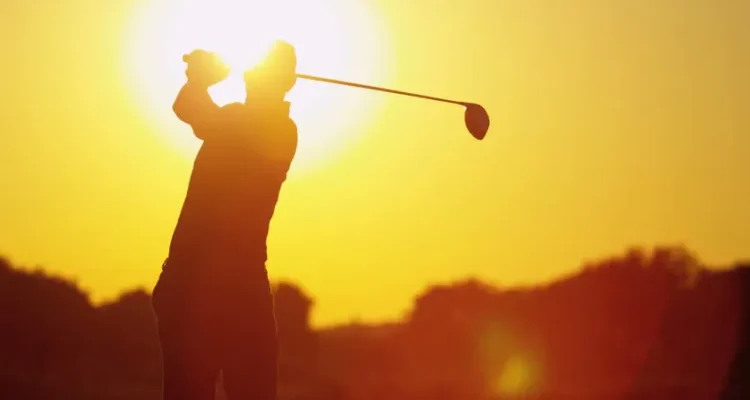By Matt Nicholson
For David Taylor, a seasoned professional caddie with a passport full of stamps and a career built on navigating chaos with clarity, success has always come from what happens in the moment. Not the easy ones—but the moments where pressure peaks, time shrinks, and everything is on the line.
He’s stood on the edge of playoffs, walked beside champions, and guided elite golfers through some of the sport’s most defining venues. His journey to those moments didn’t start on the pristine fairways of major championships. It began on the streets of Inverness, in the north of Scotland, where a kid obsessed with sport began to shape a mindset that would one day become his competitive edge.
Early Lessons in Fear and Focus
Long before Taylor ever picked up a caddie bib, he was a competitor. Football and golf were his twin obsessions—so much so that summer holidays often meant 45 holes a day at his home course, capped off with a spontaneous nine holes with his father. “I didn’t think about anything else,” he says. “I’d get up thinking about sport and go to bed the same way.”
That single-minded love carried into his studies. Though school itself wasn’t a passion, sports coaching college introduced Taylor to a new curiosity: sports psychology. He became fascinated by how the mind could drive—or derail—performance.
It was a lesson he would internalize years later, early in his career as a caddie, when pressure first started to bite. “At the start, I was terrified of making a mistake,” he admits. “But eventually I learned that hesitation was worse than being wrong. Golf doesn’t wait for you to make a perfect choice—it rewards decisiveness.”
The breakthrough came when Taylor shifted from trying to be flawless to focusing on being clear. “I realized you could be wrong, but if you’re confident and consistent, players trust you—and that makes all the difference.”
Life Off the Course: Training Grounds in Disguise
Taylor’s path into caddying wasn’t direct. At 19, he left Scotland for the United States on a coaching visa, spending a year traveling across the country and leading soccer camps for kids aged 4 to 16. He had to adapt quickly—not just to different age groups, but to different families, regional cultures, and communication styles. “It was like a crash course in how to connect with people fast,” he says. “You had to read the room instantly and lead with empathy.”
When his year in the States ended, Taylor wasn’t ready to settle. He spent three years backpacking and working across Asia and Australia—funding the journey with various jobs while absorbing new ways of thinking and being.
Eventually, he returned to Scotland and dove headfirst into another passion—music. He trained as a sound engineer and worked at two of Glasgow’s most iconic O2 venues, coordinating live shows for top-tier artists. The stakes were high. Tight schedules, last-minute changes, thousands in the audience. “It was intense, but I thrived on that pressure,” he says. “Same as now, just a different kind of headset.”
The Bet That Changed Everything
Years earlier, Taylor and a childhood friend had made a pact: if one turned professional in golf, the other would become their caddie. The friend went pro. True to his word, Taylor used vacation time to join him on tour—first as a helper, then as a serious student of the craft.
“I started learning from the veterans, studying the courses, taking every opportunity to grow,” he says. Eventually, he gave up the steady paycheck of engineering and went all-in on a dream that involved sacrifice, travel, and a lot of uncertainty.
Precision Under Pressure
Since turning full-time in 2017, Taylor has built a reputation for being one of the calmest and most prepared caddies on tour. He has worked with elite players from Europe, Asia, and the U.S.—including multi-time winners like Linn Grant, Pajaree Anannarukarn, and Yuna Nishimura.
He’s caddied in every major: The Chevron, U.S. Open, Evian, KPMG, and the Women’s British Open. His players have notched top-10 finishes, cracked the top 50 of the CME rankings, and clinched full tour cards at Q Schools under his watch.
A standout moment came in a dramatic five-hole playoff that sealed a U.S. Open qualification for a player who had never previously made the field in a 17-year pro career. “That win wasn’t just about clubs and yardages—it was about staying calm, choosing the right words, and managing the pressure when it really counted,” Taylor says.
Continuous Growth and Lifelong Learning
Taylor’s success isn’t luck—it’s built on relentless improvement. He’s earned Aimpoint certification for green reading, studies shifts in equipment technology, and keeps a close eye on course strategy trends.
He also believes learning isn’t limited to the golf world. “Whether it’s watching other caddies, getting feedback from players, or doing mental and physical work off the course—it all adds up,” he says.
His past in sports coaching and sound engineering gives him a multidisciplinary edge. He understands how people tick, how pressure behaves, and how communication can change the trajectory of a round—or a season.
Balance, Family, and the Future
Behind the scenes, Taylor prioritizes balance. Touring life is demanding—long days, endless travel, and little downtime. But he’s made space for himself, his partner Hope Barnett (an LPGA host and media creator), and their shared vision of a future beyond the course.
“In ten years, I see wins, maybe a major, Solheim Cups, maybe even Olympics,” he says. “But I also see a home, a family, and maybe a microphone in hand—helping people understand the game from a new perspective.”
He’s already thinking about how to share his knowledge: commentary, mentoring, media—any space where he can help others grow through the lens of his experience.
The Final Word: Calm, Clear, and Committed
David Taylor’s story is proof that success doesn’t come from avoiding pressure. It comes from meeting it head-on, fully prepared, and grounded in purpose. Whether it’s a playoff hole, a tour debut, or a personal transition, he brings the same mindset: clarity over perfection, process over panic.
“You don’t get to the top by coasting,” he says. “You get there by committing—to the moment, to the work, and to the people you’re walking alongside.”
And with Taylor, that walk always leads somewhere powerful.



